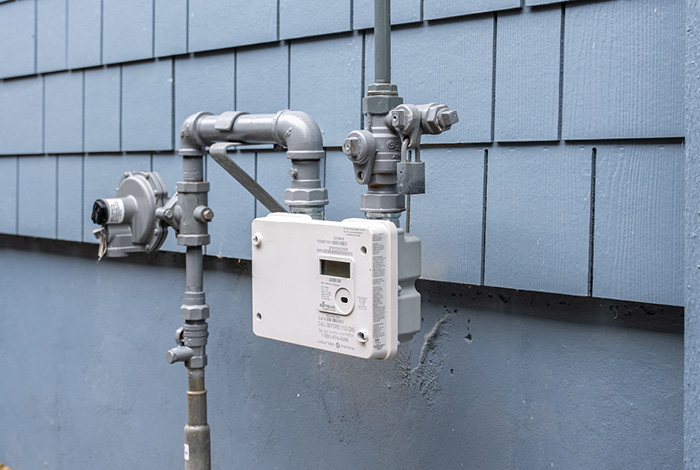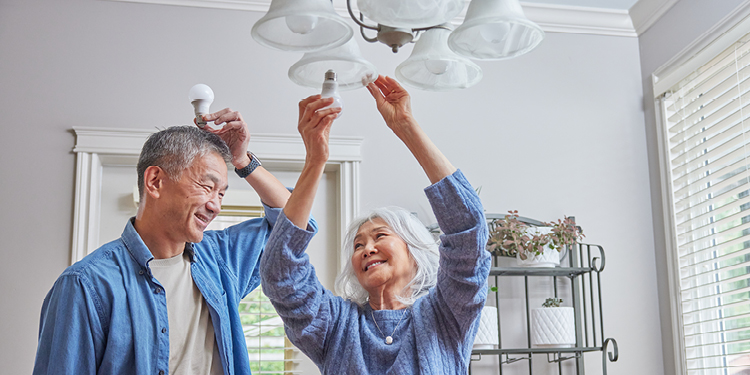Heat pump vs furnace? How to choose the best heating system for your home
March 29, 2023
Updated April 10, 2025
You know when it’s time to replace your heating system, it’s a big-ticket decision. With heating typically accounting for more than half the energy use in your home (with water heating a distant second) your choice of heating system can affect both your budget and your home’s greenhouse gas (GHG) emissions. Making an informed decision now can help reduce both for years to come.
As both a gas and electricity utility, we know there are a lot of questions and things to consider when you're making this decision. We’ve pulled together information about common scenarios to help you better understand your options and make the choice that’s best for you.

Upgrading your heating system can be a big decision so it’s important to do some research before making this decision to ensure it works for your home, budget and family.
Determining how your home is heated
The first step is to understand how your home is heated. For most homes in B.C., it’s either gas or electricity.
- Do you pay only an electricity bill (either from BC Hydro, FortisBC or your municipality)? If so, all of your appliances in the home will be powered by electricity.
- Do you pay both an electricity and gas bill? If so, this could mean your heating system or other appliances are using gas. To find out, you could look up the make and model of the unit to learn more about it.
Setting your goals before you start the project
Before you dive in, it’s important to be clear about what you need and why you want to upgrade. To start with, why are you investing in a new heating system? Is it to lower your heating costs, or simply replace an aging system? Are you looking to add cooling as well as heating? Or, do you want to lower household GHG emissions?
Thankfully, any choice you make to upgrade to a high-efficiency heating system is a positive step towards lowering your home’s energy use and GHG emissions.
If cost savings are your priority, it’s important to include the upfront purchase and installation costs of your system with expected month-to-month energy savings. Are you comfortable with the time it will take for the upfront investment to pay back in energy savings? Depending on why you’re upgrading and your current energy costs, it may make sense to pay more upfront, especially if you plan to stay in the home for a long time.
Snapshot of cost savings and installation
The month-to-month cost savings depend on a lot of variables such as the region you live in; the design and size of home you have; how many people are living in the home and how they use energy; and what your existing heating system is.
Here’s a quick look at the capital costs of upgrading a typical Surrey1 single family home and the expected annual savings in energy costs. (For a more detailed comparison, check out the table at the end of this article).
| Upgrade scenarios | Estimated upgrade costs2 | Estimated annual energy cost saving |
|---|---|---|
| Gas furnace to gas furnace8 | $4,000-$7,000 | 20% |
| Gas boiler to gas boiler9 | $7,000-$12,000 | 18% |
| Electric baseboard to mini split heat pump10 | $14,000-$20,000 | 52% |
| Electric furnace to central heat pump11 | $7,000-$12,000 | 53% |
| Gas furnace to central heat pump12 | $7,000-$12,000 | 4% |
| Gas boiler to mini split heat pump13 | $14,000-$20,000 | 1.5% |
The table above compares scenarios when upgrading from a mid-efficiency gas furnace or boiler to a high-efficiency model. The scenarios with a heat pump used a heating seasonal performance factor of 10.
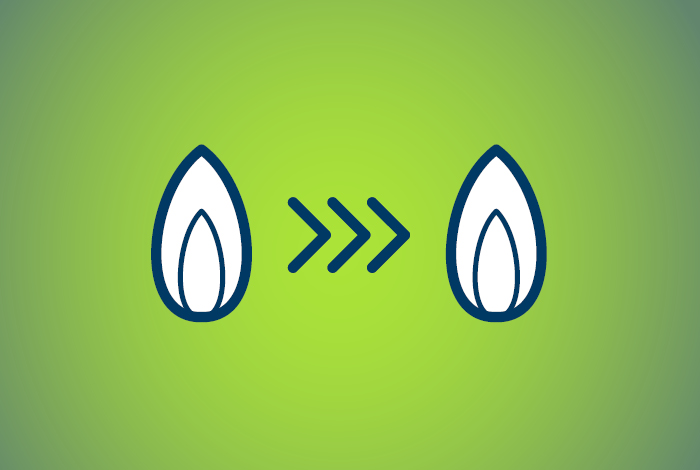
Scenario 1: Going from gas to gas
If your home is heated with gas, you likely have either a forced-air furnace or a boiler. Upgrading to a high-efficiency furnace or boiler can help you lower energy use, energy costs and GHG emissions over the long term9 while maintaining an older, less efficient model can be costing you more than necessary to heat your home.
The relative ease of the upgrade and option to sign up for lower carbon3 Renewable Natural Gas4 (RNG) make this one of the quickest and more affordable ways to reduce energy use and lower GHG emissions. It’s usually a straightforward process because the existing ductwork, infrastructure and gas hookup are already in place. If you want to further reduce your GHG emissions, you can designate up to 100 per cent of the gas you use as RNG.
Can I add an air conditioner to my gas furnace?
You may want to make your home more comfortable in the summer months by adding a central air conditioning unit to your gas furnace. Powered by electricity, these units use the existing ductwork connected to your furnace to circulate cold air throughout your home.
There are a number of variables that can affect both costs and savings. You can check our home energy calculator to help compare heating systems for your home.
Tips and considerations
- To lower your installation costs and maximize your energy savings, consider upgrading to a high-efficiency model.
- Upgrade before it’s an emergency. If your old system fails, there may be fewer high-efficiency options available on short notice.
- Costs will vary, depending on the unique characteristics of your home. Consider getting quotes from three licensed gas contractors. You can find a contractor for your area through our Trade Ally Network program.
- Your contractor can help make sure the replacement unit is sized correctly for your home.
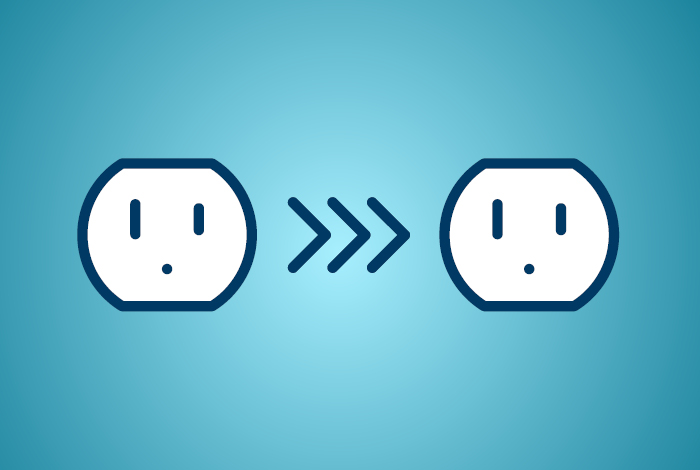
Scenario 2: Going from electric to electric
If your home is heated with baseboards or an electric furnace (also known as resistance heating), upgrading to a high-efficiency heat pump is a great option for lowering your long-term energy costs. Because of the way they transfer heat from one area to another, heat pumps are very energy efficient and can achieve efficiencies of more than 100 per cent in ideal conditions. In our example above, upgrading from an old electric system to a heat pump would save an estimated 50 per cent per year or more in energy costs.
Another benefit with a heat pump is its capacity to act as a cooling unit, as well as heating. While this can be great on hot summer days, it also means your energy use could actually increase over the summer months so be sure to consider this in your budget.
If you have the existing ductwork, infrastructure and capacity on your home’s electric service, the upgrade can also be relatively straightforward. However, if you require these to be installed or upgraded, this can significantly increase your installation costs and prolong the payback period. Speaking to your contractor can help inform you if electrical upgrades are required.
There are a number of variables that will affect the total cost of these upgrades. You can check our home energy calculator or BC Hydro’s heat pump cost calculator to help compare these heating systems for your unique situation.
Tips and considerations
- To lower your installation costs and maximize your energy savings, consider upgrading to a high-efficiency model that is eligible for FortisBC, CleanBC or BC Hydro5 rebates.
- Central heat pump units are installed outside the home so consider where it can be located and if the noise could affect your neighbours.
- If moving from electric baseboards to a heat pump, keep in mind there is no existing ductwork throughout your home. This may mean you will have to install a mini-split heat pump outside with ductless wall units inside your home in multiple locations. You will have the benefit of controlling the temperature in each room but they will be visible in your living spaces.
- Costs will vary, depending on the unique characteristics of your home. Consider getting quotes from three licensed heat pump contractors to compare prices and information.
- Note: to be eligible for heat pump rebates, you will need to use a contractor who is registered with the Home Performance Contractor Network (HPCN).
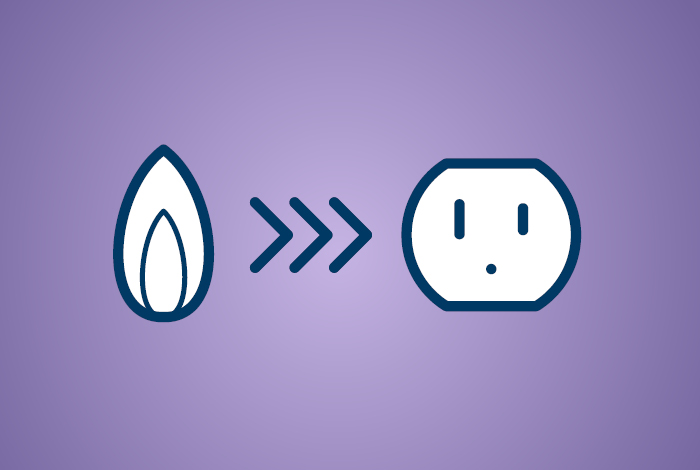
Scenario 3: Going from gas to electric
If you prefer to switch your older gas furnace or boiler for a new energy-efficient electric heat pump, it can be an effective but a potentially more complex approach to lowering GHG emissions and energy use.
It becomes more challenging if you need electrical upgrades to your home or have to add additional ducting, but it can be done. Many older homes in the FortisBC electricity service area were built with 100-amp service and may need a 200-amp service to run a heat pump. To upgrade your electrical panel, it can cost up to $12,000 with an average cost of around $5,000.
You may also need to upgrade the electrical service running from the street to your home, which is an additional cost to factor into your budget. To do this, contact your electricity service provider, either BC Hydro or FortisBC. You will likely need to work with a licensed electrician as well as a qualified heat pump installer who is registered with the HPCN.

When replacing your heating system, or any piece of equipment in your home, it’s important to use a licensed contractor. We recommend you get around three quotes from different companies to compare costs. If you’re looking for a contractor, you can search our Trade Ally Network directory to find one in your area.
This scenario typically returns the least energy cost savings compared to the other two, yet can have the highest installation costs. Much of this comes down to the type and size of home, the region and the existing heating system. It may be the case where you’ve made the switch from a gas furnace to a heat pump and enjoy the ability to have cooling in the summer months, are using energy more efficiently and have lowered GHG emissions. On the other hand, it’s also possible that the costs of switching to an electric system are too high and choosing to keep your gas furnace and subscribe to lower carbon RNG is the more cost-effective approach. There are options out there and it’s up to you to make the choice that best suits your specific needs.
Questions and considerations
- What is your current gas heating system? If it’s a furnace, you may be able to use the existing ductwork and install a central heat pump. If it’s a boiler, you may need to install multiple ductless units in different locations in your home.
- Do you need to upgrade your electrical panel? If so, how much will this cost?
- Do you need to upgrade the electrical service from the street to your home? If so, what is the cost?
- Are you comfortable with a longer lead time and working with multiple contractors to upgrade your electrical service, remove the gas system and add a heat pump?
- Will you need to keep your gas system to help meet the energy needs of your home on colder weather days? While heat pump technology is always improving, the performance and efficiency can decrease during colder weather especially in colder B.C. climates.
- Do both the installation costs and longer-term energy costs fit with your budget? How much can this be offset by CleanBC rebates?
The choice is yours
Remember, there isn’t a right way or a wrong way. You can reduce energy use and GHG emissions by upgrading to a high-efficiency gas system and signing up for RNG, or you can opt for an electric heat pump that can make your home more energy efficient. For both scenarios, you have the option to add cooling, either with adding an air conditioning unit onto your gas furnace or with a heat pump that heats and cools. You can make the choice that best fits your preferences, goals and budget.
We’ll also continue to look for ways to help our customers use energy efficiently in their homes with new, innovative technology and support their efforts to lower GHG emissions. For example, we are testing the effectiveness of gas-fired heat pumps for residential settings, an approach already in use in commercial settings.
We’re always here to help if you have any specific questions; call 1-888-224-2710 (gas customers) or 1-866-436-7847 (FortisBC electricity customers).
Common upgrade scenarios
Below is a table to help you consider different upgrade scenarios and variables and make an informed choice.
| Scenarios | Estimated annual energy costs6 | Estimated energy cost savings per year | Estimated upgrade costs7 | Rebates | Additional electrical upgrades needed |
|---|---|---|---|---|---|
| Gas furnace to gas furnace8 | $900 | 20% | $4,000-$7,000 | Not available as of January 1, 2024. Learn more. | No |
| Gas boiler to gas boiler9 | $900 | 18% | $7,000-$12,000 | Not available as of January 1, 2024. Learn more. | No |
| Electric baseboard to mini split heat pump10 | $1,100 | 52% | $14,000-$20,000 | Yes, up to $1,000 from BC Hydro or up to $2,000 from FortisBC. This is based on who your electricity service provider is. | Possibly, check with a contractor |
| Electric furnace to central heat pump11 | $1,100 | 53% | $7,000-$12,000 | Yes, up to $2,000 from BC Hydro or FortisBC. This is based on who your electricity service provider is. | Possibly, check with a contractor |
| Gas furnace to central heat pump12 | $1,100 | 4% | $7,000-$12,000 | Yes, up to $9,000 from BC Hydro and CleanBC. | Likely, depending on the capacity of your electrical panel |
| Gas boiler to mini split heat pump13 | $1,100 | 1.5% | $14,000-$20,000 | Yes, up to $9,000 from BC Hydro and CleanBC. | Likely, depending on the capacity of your electrical panel |
Table compares different variables based on common upgrade scenarios.
1 These calculations are based on a 2,400 square foot single family home in Surrey with four occupants, ductwork already in the home and average insulation (1970 to 1990s home).
2 Approximate range of costs for both equipment and basic installation for a typical existing home in BC. Costs are not specific to certain structural, distribution, venting or other requirements. Contact a licensed gas or electrical contractor to get a quote specific to your home.
3When compared to the lifecycle carbon intensity of conventional natural gas. The burner tip emission factor of FortisBC's current Renewable Natural Gas (also called RNG or biomethane) portfolio is 0.27 grams of carbon dioxide equivalent per megajoule of energy (gCO2e/MJ). FortisBC's current RNG portfolio lifecycle emissions for stationary combustion are -22 gCO2e/MJ. This is below B.C.'s lifecycle carbon intensity threshold of 30.8 gCO2e/MJ as set out in the 2024 Greenhouse Gas Reduction Regulation amendments.
4Renewable Natural Gas (also called RNG or biomethane) is produced in a different manner than conventional natural gas. It is derived from biogas, which is produced from decomposing organic waste from landfills, agricultural waste and wastewater from treatment facilities. The biogas is captured and cleaned to create RNG. When RNG is added to North America’s natural gas system, it mixes with conventional natural gas. This means we’re unable to direct RNG to a specific customer. But the more RNG is added to the gas system, the less conventional natural gas is needed, thereby reducing the use of fossil fuels and overall greenhouse gas emissions.
5 FortisBC, CleanBC and BC Hydro offer rebates through the CleanBC Better Homes and Home Renovation Rebate Program. Maximum one primary space heating system rebate per home. Rebates between the three organizations cannot be stacked, are subject to change and customers must meet eligibility requirements.
6 All numbers are approximate and will depend on factors in the home and the type of equipment installed. These calculations are based on a 2,400 square foot single family home in the Lower Mainland with four occupants, ductwork already in the home and average insulation (1970 to 1990s home). Rates included: $14.7848/GJ natural gas, $0.095/kWh electricity (step 1) and $0.1408/kWh electricity (step 2).
7 Approximate range of costs for both equipment and basic installation for a typical existing home in B.C. Costs are not specific to certain structural, distribution, venting or other requirements. Contact a licensed gas or electrical contractor to get a quote specific to your home.
8 Scenario based on upgrading from a mid-efficiency gas furnace (0.78 AFUE) to a high-efficient furnace (0.98 AFUE).
9 Scenario based on upgrading from a mid-efficiency gas boiler (0.80 AFUE) to a high-efficient gas boiler (0.98 AFUE).
10 Scenario based on high-efficiency heat pump with a HSPF of 10.
11 Scenario based on an electric furnace to a high-efficiency heat pump with a HSPF of 10.
12 Scenario based on upgrading from a mid-efficiency gas furnace (0.78 AFUE) to a central heat pump with a HSPF of 10.
13 Scenario based on upgrading from a mid-efficiency gas boiler (0.80 AFUE) to a high-efficient ductless mini-split heat pump.

